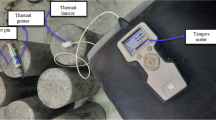Abstract
In this article laboratory and analytical studies of the chloride migration coefficient, D, are presented. The result of studies on chloride migration of Self-Compacting Concrete, SCC, are compared with the corresponding properties of normal concrete with the same water-cement ratio, w/c and air content. Both 28 and 90 days' age applied at the start of the testing. Six SCC were studied and 2 NC, all with w/c=0.39. The effect of normal and reversed order of mixing (filler last), increased amount of filler, type of filler, limestone powder, increased air content and large hydrostatic concrete pressure were investigated.
Résumé
Cet article traite des études en laboratoire et des analyses concernant le coefficient de migration du chlorure. Le résultat des études sur l'admission en chlorure du béton autocompactant a été comparé avec les propriétés de celles d'un béton courant ayant le même taux d'eau/ciment et la même teneur en air. Des bétons de 28 et de 90 jours ont été utilisés au début des tests. L'étude a porté sur 6 bétons auto-compactants et 2 bétons normaux, tous ayant un taux d'eau/ciment de 0,39. C'est dans ce contexte qu'a été étudiée l'influence d'un mélange normal et inversé (dernier apport), de l'augmentation de la quantité de matériau de remplissage, du type de matériau de remplissage, de la poudre de pierre à chaux, de l'augmentation de la teneur en air et d'une forte compression hydrostatique du béton.
Similar content being viewed by others
References
Nilsson, M. and Petersson, Ö., ‘The first bridge made of SCC’,Väg-och Vattenbyggaren (2) (1998) 28–31.
Söderlind, L., ‘Full-scale tests of SCC for dwelling houses’, in ‘Symposium on SCC’, Stockholm, Eds. Skarendahl, Å, and Petersson, Ö. (RILEM, 1999) 723–728.
Persson, B., ‘Mix proportions and strength of SCC for production of high strength poles, piles and pillars’, in ‘1. Münchener Baustoffseminar Selbstverdichtender Beton’, Oct. 2001, Ed. Peter Schiessl (TUM, Munich, 2001) 31–39.
Persson, B., ‘Assessment of D, Internal Frost Resistance, Salt Frost Scaling and Sulphate Resistance of SCC’, TVBM-3100, Lund Institute of Technology, Lund (2001) 86 p.
CTH Rapid Test for Determination of D in Concrete, NT BUILD 492 (2000).
Tang, L. and Nilsson, L.-O., ‘Modelling of chloride penetration into concrete—Tracing five years' field exposure’,Concrete Science Engineering 2 (2000) 170–175.
Johannesson, B., ‘Transport and sorption phenomena in concrete and other porous media’, TVBM-1019 Lund Institute of Technology, Lund (2000) 491 p.
AASHTO T 271-831, ‘Rapid determination of chloride permeability of concrete’.
Geiker, M., Thaulow, N. and Andersen, P.J., ‘Assessment of rapid test of concrete permeability test of concrete with and without mineral admixtures’, in ‘Durability of Concrete and Components’, Brighton, (Chapman & Hall, 1990) 52–61.
Persson, B., ‘A background for the choice of mix design of the concrete for the Great Belt link’, Report U91.02, Div. Building Materials, Lund Institute of Technology, Lund, (1991) 102 p.
Boubitsas, D. and Paulou, K., ‘SCC for marine environment’, TVBM-5048, Lund Institute of Technology, Lund (2000) 55 p.
Buenfeld, N., Personal information, Imperial College, London (2001).
Persson, B., ‘Moisture in concrete subjected to different kinds of curing’,Mater. Struct. 30 (1997) 533–544.
Persson, B., ‘Self-desiccation and Its Importance in Concrete Technology’,Nordic Concrete Research 20 (1998) 120–129.
Persson, B., ‘Shrinkage of HPC’, in ‘International Conference on early Age Cracking in Concrete’, Haifa, Ed. Bentur, A. (RILEM, 2001) 301–311.
Powers, T.G. and Brownyard, T.L., ‘Studies of the physical properties of hardened Portland cement paste’,PCA 22. (1948) 473–488. 845–864.
Nilsson, L.-O., Hedenblad, G. and Norling-Mjörnell, K. ‘Suction after long time’, HPC Handbook, Svensk Byggtjänst, Stockholm, 2000, 209–226.
Persson, B., ‘Seven-year study of the effect of silica fume in concrete’,Advanced Cement-Based Materials 7 (1998) 139–155.
Castel, A., François, R. and Arliguie, G., ‘Clarification of corrosion of reinforcement in concrete structures exposed to chloride environment’, in ‘fib Meeting and the Nordic Mini Seminar’, Gothenbourg, Sweden (2001) 10 p.
Collepardi, M.et al., ‘The kinetics of chloride ions penetrations in concrete’,Il Cemento 67 (1970) 157–164.
Tuutti, K., ‘Corrosion of steel in concrete’, Report 4:82, CBI, Stockholm (1982).
Tang, L. and Nilsson, L.-O., ‘Rapid determination of chloride diffusivity of concrete by applying an electric field’,ACI Material Journal 49 (1) (1992) 49–53.
Maage, M., Helland, S. and Carlsen, J.E., ‘Chloride penetration in HPC exposed to marine environment’, RILEM Workshop on Durability, Ed. H. Sommer (1994) 194–207.
Poulsen, E., ‘Predict. Models STAR 53’, Danish Road Direct., Ed. Nilsson, L.-O. (1996).
Pettersson, Ö., ‘Dispersion and frost resistance investigation of four types of limestone filler for SCC’, 2000-27, Cement and Concrete Institute, Stockholm, 2000, 14 p.
Neville, A.M. and Brooks, J.J., ‘Concrete Technology’ (Longman, Singapore, 1987) 110.
Persson, B., ‘Long-term shrinkage of HPC’ in 10th Congress on the Chemistry of Cement, 2ii073, Gothenburg, Ed. Justnes, H. (1997) 9 p.
Persson, B., ‘Long-term effect of silica fume on the principal properties of low-temperature-cured ceramic’,Cement and Concrete Research 27 (1997) 1667–1680.
Persson, B., ‘Pozzolanic interaction between Portland cement and silica fume in concrete’, in ‘Sixth CANMET/ACI Int. Conference’, Bangkok (1998) 631–660.
Persson, B., ‘Chloride diffusion coefficient and salt frost scaling of SCC and of NC’, Nordic Seminar-fib Meeting, Chalmers, Gothenburg. Ed. Nilsson, L.-O. (2001) 13 p.
Persson, B., ‘Chloride migration coefficient of SCC’, in ‘Nordic Seminar on Durability of Exposed Concrete Containing Secondary Cementitious Materials’, Hirtshals. Ed. D. Bager. Publ. by Nordic Concrete Federation, Oslo (2001) 187–207.
Author information
Authors and Affiliations
Additional information
Editorial Note Dr. Bertil Persson is a RILEM Senior Member. He participates in RILEM TCs LTP' Life time performance of materials and structures’, URM ‘Use of recycled materials’, 196-ICC ‘Internal curing of concretes’ and 195-DTD ‘Recommendation for test methods for autogenous deformation and thermal dilation of early age concrete’.
Rights and permissions
About this article
Cite this article
Persson, B. Chloride migration coefficient of self-compacting concrete. Mat. Struct. 37, 82–91 (2004). https://doi.org/10.1007/BF02486603
Issue Date:
DOI: https://doi.org/10.1007/BF02486603




